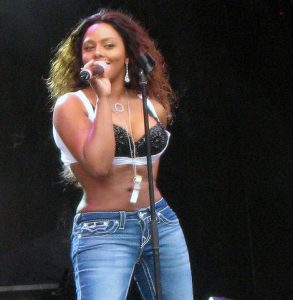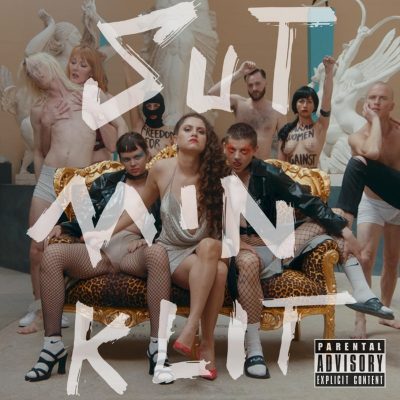How many of you have felt personally victimized by Nikoline?[1] The list of her targets in “Sut Min Klit” (Danish for “Suck my clit”) is long: her male peers, pedophiles, rapists, religious leaders (all of them grouped as sexual predators in the same way), and even other women. Nikoline’s recently unleashed song and video one-two punch is impossible to ignore, both perfectly designed to provoke a strong reaction. (Listen to the song here).

The song has generated headlines since it was released. Can you consider Nikoline a feminist? Are people as offended when there’s a man behind lyrics like these? Isn’t her inflexible standpoint as bad as the extremism she denounces? These are all questions that can spark interesting debates[2], but I’m just here to show you how that no matter how current it sounds, Nikoline’s song has actually been a long time in the making and it belongs to a well-established tradition of fearless female rappers who made it their mission to take the spotlight in the very much male dominated genre with similar linguistic and discursive approaches.
Lil’ Kim once rapped “And if I was dude I’d tell y’all to suck my dick”, and now Nikoline has decided that this act of defiance doesn’t require the use of male genitalia. The female anatomy will do. It’s right there in the title of the song, and in case anyone doubts where she stands, she adds:
“Fuck censur af kvinders anatomi / Fuck the censorship of women’s anatomy[3]”
Towards the end of the song, Nikoline also compares her clitoris to an iceberg, invoking an image of danger through the comparison to the hidden threat of the ice mountain of which we only see the tip. While it is certainly striking to hear the word “clit” in music, it’s not anything that (again) Lil’ Kim hasn’t done before, starting with several songs of Hard Core, all the way back in 1996.
In “Sut Min Klit” Nikoline is storming (because entering is too neutral to describe what she does here) the male-dominated field of rap both implicitly (merely by being a female rapper) and explicitly (telling pretty much all men who have public positions of power off – be it her male counterparts in the Danish rap scene, politicians, religious figures…).
Rap, like language and gender, is socially constructed. Meanings and identities are created and altered in interaction. In this way, rappers are in constant dialogue with each other and no one is truly isolated in the scene. Rap lyrics usually contain several layers of intertextuality: you have to keep up with the news and be familiar with rap’s present and past to decode every lyric (or bar). From Danish rap group Suspekt (named directly) to Beyoncé, there is a lot to entangle and contextualize in Nikoline’s song. Intertextuality in rap also contributes to creating the feeling of a community. The way I see it, rappers share a community of practice. The three features that Wenger established as basic in communities of practice are present:
- Mutual engagement.
- A joint negotiated enterprise.
- A shared repertoire of negotiable resources accumulated over time.
Women in mixed-gender communities of practice are often seen (and see themselves) as “interlopers”. An insightful study by Holmes and Schnurr about women in the workplace (also a male-dominated space until recently that can be compared to rap) reveals that traditional femininity is seen as weak and unprofessional and it has negative connotations. Women have two reactions to this: a fierce adherence to the rules of the community of practice (so that they get recognized as legitimate members of it) and a rejection of traditional codes of femininity. Nikoline does both by the book, following rap’s subversive and combative spirit, and criticizing women who are obsessed with beauty.
Rap music and hip hop culture have evolved since their origins in the late 1970s and have expanded from New York to reach every corner of the world. Rap is a style of music made by (mostly) young people who often position themselves as outsiders, members of marginal groups in society who enact power through their music. In a wider sense, rap is all about power, which is manifested by the one who holds the mic. A rapper has the duration of a song to prove themselves worthy of holding the linguistic floor. Not all rappers would consider themselves “street reporters” like NWA, but many of them still comment on current events. While pop songs usually strive to have universal lyrics that everyone can relate to and timeless melodies that can be sung today and in 50 years’ time, rap retains a sense of urgency. Nikoline’s references to #MeToo and the infamous “Grab them by the pussy” Trump quote are some examples. In fact, she subverts that quote when she announces a “grab them by the balls tsunami”[4].
While it takes cues from oral speech styles, language in rap performance is often more calculated than spontaneous. In “Sut Min Klit” Nikoline consciously infuses her music with a balance of masculine and feminine discourses that reveals the dichotomy present in most rap music made by women.
Maskulin og feminim er bare yin/yang / Masculine and feminine are just yin and yang
Gender roles in rap generally present men as assertive and aggressive and women as passive and submissive. For example, in their song “Kinky Fætter”, Suspekt feature a female voice moaning, and rapper Orgi-E instructs a woman to “suck his dick”. Nikoline appropriates these terms and reverts the male gaze, displaying the objectification of men at the end of “Sut Min Klit”:
Du kan li det/ You like it
Yeah du stønner blidt, når hun siger/ Yeah you moan softly, when she says
Knægt ned på knæ/ Boy, on your knees
The male “you” in these lines is cast in the submissive role, taking orders from the woman to get on his knees. He is also the one doing the moaning, moreover doing it softly, an adjective that recalls qualities traditionally associated with femininity.
Throughout her song, Nikoline is presenting herself as both desirable (“Alle kvinder bliver lesbiske når jeg kommer forbi”/ “All women become lesbians when I pass by”) and menacing (“Jeg er alle religioners Nemesis” / “I am the nemesis of all religions”). She uses aggressive language, which is usually coded as masculine, as opposed to the notion that women are more likely to use cooperative language. She also employs violent images borrowed from US gangsta rappers:
Det er en indlysende sag / It is an obvious case
At pædofile skal have skåret pikken af / That pedophiles should have their dicks cut off
Min AK-47 op i deres røv til de forbløder / My AK-47[5] up their ass till they bleed to death
On the other hand, Nikoline draws a line between her and other women to construct her own sense of femininity. While she denounces misogyny, she’s still putting down other women to elevate herself, whether it’s “dumme piger” / “stupid girls” who dance to Suspekt’s music or:
Usikre tøser i flok, / Insecure chicks in flocks,
som ikk tør noget uden makeup / who don’t dare do anything without makeup

Female rappers are divisive by nature, at times admired for their subversive power and at times accused of being complicit in a sexist industry. The mid 1990s saw the emergence of a group of female rappers in the US who rejected fitting into male codes of dressing (like the oversized clothes) and proclaimed an aggressively sexual femininity. Traces of their influence can be felt in “Sut Min Klit”. The way that Nikoline portrays herself as in charge, the way she unapologetically expresses her rejection of the censorship of the female anatomy, the way she reverts the male gaze and she uses language and images traditionally coded as masculine… it would make the likes of Eve, Foxy Brown and Lil’ Kim proud.
* This article is based on some of the ideas I presented in my MA thesis earlier this year, which in turn owes a great debt to a very, very long list of research studies in domains as diverse as hip hop studies, sociolinguistics with a focus on gender, communities of practice, discourse analysis, and intertextuality (among others). Here are some of my suggestions if you would like to know more about the topics in the article:
If you’re interested in language and gender, and communities of practice, Language and Gender by Penelope Eckert and Sally McConnell-Ginet is a great introduction.
If you want to go deeper in the analysis of female rappers, Tricia Rose and Imani Perry (Prophets of the Hood especially) are your women.
For an approach to hip hop and linguistics, look for the many books and articles written by H. Samy Alim.
Rocío Lorenzo López finished her MA in Linguistics at Aarhus University last June and now works as a project manager for linguistic validation in Lyon (France).
References:
[1]If you don’t recognize this reference, go and watch Mean Girls now. You’ll thank me later.
[2]I would like to thank my Danish friends for their very helpful comments on these subjects and the song itself.
[3]Thank you Christina for the translation to English.
[4]In English in the original lyrics. Other words like “whatever” and “yeah” are in English as well, reflecting a linguistic influence from the birthplace of rap that can also be heard in rap songs made in other languages such as Korean or Spanish.
[5]The AK-47 is an assault rifle and the most popular firearm in the lyrics of gangsta rappers. You can find references to it in the lyrics of NWA, 50 Cent and (who else?) Lil’ Kim.







